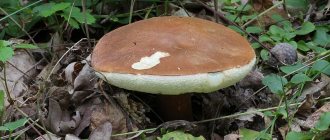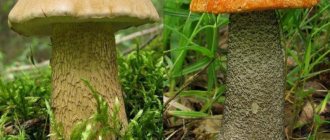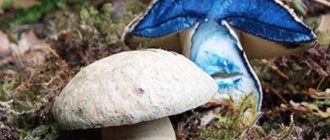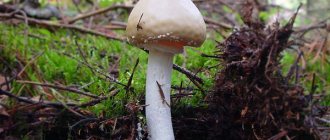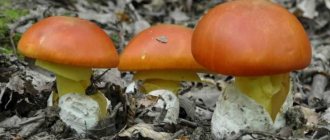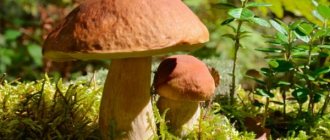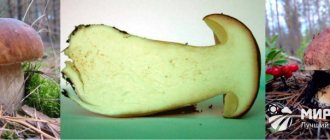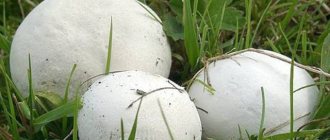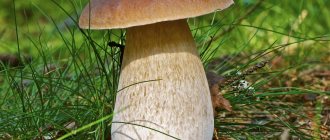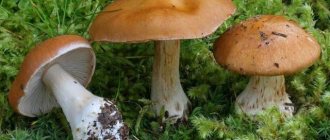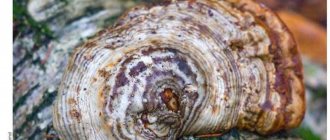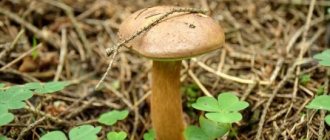Short description
| Type of mushrooms: | conditionally edible |
| Other names (synonyms): | Gyroporus chestnut, Chestnut mushroom, hare mushroom |
| Latin name: | Gyroporus castaneus |
| Family: | Gyroporaceae |
| Distinctive feature: | Gyroporus chestnut - most likely received this name because of its chestnut color. These are one of the favorite delicacies of forest dwellers. |
| Beginning of the season: | July |
| End of season: | September |
| Leg height (cm): | 3-6 cm |
| Cap width (cm): | 2.5-5 (10) cm |
| Smell: | sourish |
| Taste: | not expressed |
| Tasting score: | Have you tried this mushroom? Then rate it! |
| Hat: | in youth hemispherical, later convex, cushion-shaped. Color ranges from yellow-brown to brown, dull. The skin is smooth, the edges are sharp. |
| Leg: | conical, slightly separated from the cap, smooth. Same color as the hat. |
| Hymenophore (bottom of cap): | has a porous surface: initially white to cream, becoming dull yellow. |
| Disputes: | elliptical, smooth, 8.7-12 x 5-7 microns. |
| Pulp: | hard, whitish. |
| Natural environment and mycorrhiza: | in deciduous and coniferous forests. |
| False doubles: | Gyroporus is blue - has a hollow stalk, but turns blue at the break. |
| Growing: | – |
| Use: | Suitable only for drying, as it acquires a bitter taste when cooked. |
| Medicinal properties: | – |
| Spreading: | Europe, North America. |
The chestnut mushroom is a little-known edible species that is little known to a wide range of lovers of quiet hunting and has high taste qualities. Other names: hare mushroom, sand mushroom, Gyroporus chestnut, chestnut mushroom, Gyroporus chestnut, hare's tail. Latin name: Gyroporus castaneus.
How to distinguish from doubles?
A photo and description of the chestnut mushroom will help you not to confuse it with similar relatives, both edible and inedible. The main differences are presented in table form. Kashtannik and its doubles
| Mushroom | Chestnut | White | Poddubovik | Polish |
| hat | Most often brown | Regular shape, convex, velvety to the touch | Very similar to the chestnut cap in shape and color | Much smaller in size, different in color, often chocolate |
| Leg | Light brown. The color does not change when cut. Height no more than 8 cm. Leg shape – cylindrical | Gray-white, darkens when cut. The average height is about 12 cm. The shape is characteristic, reminiscent of a round barrel | Yellow-orange, turns blue when cut | Light brown, but smaller in size than chestnut |
It is very important to be able to distinguish between edible and inedible counterparts. So, the chestnut tree has one brother that looks similar to it, but is inedible due to the specific taste of the pulp. This is a gall mushroom or mustard, also a representative of the Boletaceae family. It is not poisonous, but just one, accidentally caught, mushroom can spoil the entire dish with bitterness. It is not difficult to recognize it: when cut, the stem will characteristically turn pink. These signs will help prevent mistakes when collecting. It is interesting that the chestnut mushroom, the photo of which is presented below, has no poisonous analogues in nature.
Rabbit mushroom (Gyroporus castaneus)
Taxonomy:
- Division: Basidiomycota (Basidiomycetes)
- Subdivision: Agaricomycotina (Agaricomycetes)
- Class: Agaricomycetes (Agaricomycetes)
- Subclass: Agaricomycetidae (Agaricomycetes)
- Order: Boletales
- Family: Gyroporaceae
- Genus: Gyroporus (Gyroporus)
- Species: Gyroporus castaneus (Hare mushroom)
- Other names for the mushroom:
- Gyroporus chestnut
- Chestnut mushroom
- Kashtanovik
Other names:
- Chestnut mushroom
- Kashtanovik
- hare mushroom
Cap: Rusty-brown, red-brown or chestnut-brown, convex in young chestnut mushrooms, flat or cushion-shaped in maturity, 40-110 mm in diameter.
The surface of the chestnut Gyroporus cap is initially velvety or slightly fluffy, but later becomes bare. In dry weather it often cracks. The tubes are initially white, yellow at maturity, non-blue when cut, initially adherent at the stem, later free, up to 8 mm long. The pores are small, rounded, initially white, then yellow; when pressure is applied to them, brown spots remain. Leg: Central or eccentric, irregularly cylindrical or club-shaped, flattened, glabrous, dry, red-brown, 35-80 mm tall and 8-30 mm thick. The inside is solid, later with cotton filling, at maturity it is hollow or with chambers.
Pulp: White, does not change color when cut. At first it is hard, fleshy, becomes fragile with age, the taste and smell are inexpressive.
Spore Powder: Pale yellow.
Spores: 7-10 x 4-6 µm, ellipsoidal, smooth, colorless or with a delicate yellowish tint.
Growth: Chestnut mushroom grows from July to November in deciduous and coniferous forests. It most often grows in sandy soil in warm, dry areas. The fruiting bodies grow singly and scattered.
Use: A little-known edible mushroom, but in terms of taste it cannot be compared with blue gyroporus. When cooked, it acquires a bitter taste. When dried, the bitterness disappears. Therefore, chestnut fruit is suitable mainly for drying.
Similarity: Has no resemblance to poisonous mushrooms.
Application
Preparations from these mushrooms help with cerebral vascular spasms and epilepsy.
An aqueous tincture is used to treat joints and psoriasis. If necessary, decoctions are used as an emetic and anthelmintic.
Chestnut mushroom has a weak aroma and a specific taste. To enhance the smell, it is subjected to heat treatment; it is more suitable for frying or boiling. It is not suitable for pickling due to its bitter taste. Hares love it, hence the second name of the mushroom - Hare.
Description of chestnut mushroom.
Young chestnut trees have convex caps, then become cushion-shaped or flat. Their diameter ranges from 40 to 110 millimeters. The color of the cap is red-brown, rusty-brown or brown-chestnut. The surface of the cap of this mushroom is initially slightly pubescent or velvety, and later may become bare. In dry weather, the cap of the chestnut mushroom often cracks.
There are tubes under the cap. Young mushrooms have white tubes, then yellow. The tubes do not turn blue when cut. At first they are attached to the leg, and towards maturity they become free. The length of the tubes is about 8 millimeters. Small pores of a rounded shape are visible on the tubes. At first they are white, then yellow; if you press on them, brown spots appear. The spores are ellipsoidal, smooth, colorless, with only a noticeable yellowish tint. Spore powder is pale yellow in color.
The leg of the hare mushroom is central or eccentric. Its shape is club-shaped or unevenly cylindrical, it is flattened on the sides. Its length is 35-80 millimeters, and its girth is 8-30 millimeters. Its surface is dry and bare. The inside of the leg is solid, later it becomes cottony, and by old age chambers appear in it or it becomes hollow.
The pulp is white and does not change when cut. At first it is fleshy and hard, but later becomes brittle. The smell and taste of the pulp are unexpressed.
Pulp
White, while the color on the fault remains unchanged. Initially, the flesh is fleshy and hard, but becomes more fragile over time. The taste and smell are weak, with a hazelnut flavor.
Spore powder
Light yellow.
Tubular layer
White at first, yellow-cream in older mushrooms. The tubes are short, freely located. If you press on them, brown spots will remain.
Description of the cap
Chestnut gyroporus - this is what the chestnut mushroom is called in science - has no specific distinctive features and is therefore little recognizable even by experienced mushroom pickers. In appearance, it is almost a complete analogue of the Polish mushroom, differing from it not only in its larger cap and stem, but also in its less bright color. It is also similar to the porcini mushroom, but it is not difficult to distinguish them: the chestnut mushroom has a brown stem, and the white mushroom has a greyish stem.
It is classified as tubular, that is, the cap on the reverse side consists of numerous small tubes, light cream or yellowish in color.
The hat has the following distinctive features:
- Slightly convex, mushrooms with a flat cap are rare.
- Average diameter 5-8 cm.
- Chestnut color is the most common, but you can also find mushrooms and brown, reddish, brown, rusty varieties.
- The tubes of young mushrooms are white, becoming yellowish with age.
- Dry to the touch, without mucus.
Often in dry times the cap becomes covered with cracks due to lack of moisture.
What does the leg look like?
The stem of a chestnut mushroom is as follows:
- Cylindrical shape.
- Average length 5-8 cm.
- Brown in color, darker than the cap.
- The inside of adult mushrooms is hollow, while young ones have a filling that looks like cotton wool.
- Does not change color when cut.
The flesh is white, hard in young mushrooms, but becomes brittle as it matures. The smell is very weak, but the characteristic bitter taste can be felt even in raw mushrooms.
Natural enemies of the cabbage butterfly
Photo: White cabbage
About 80 percent of the larvae are killed by the Apanteles glomeratus, which injects its eggs into them. This happens while the caterpillars are still small. The predator's larvae hatch inside the host's body and slowly devour it, but the cabbage weed continues to live and consume food. When the wasp larvae grow, they eat the host's vital organs, killing her and burrowing through her skin.
Sometimes you can see the dry remains of a caterpillar shell on a cabbage leaf, surrounded by a cluster of up to 80 tiny yellow fluffy cocoons. The following spring, the riders emerge from their cocoons and fly in search of new cabbage white caterpillars. Having found a potential victim, the female ichneumon ichneumon probes it with her antennae to assess its size.
The size of the larva must be such that the offspring that will develop inside have enough food. An individual that is too old can turn into a pupa before the larvae of the parasitic insect develop there. The riders pierce the victim with their ovipositor and release one egg. The female can make several such injections into one caterpillar.
Many pupae, when they have just formed and their covers are still soft, are attacked by the parasitoid wasp Pteromalus puparum. She lays her eggs there. Up to 200 predatory individuals can develop in one pupa. In three weeks, the larvae develop into the cabbage pupa. If this happens in the summer, then the insects come out of it as adult insects; in the autumn, they remain to winter inside.
The cabbage white does not have a specific group of predators. They are preyed upon by a wide range of different birds. They are eaten by some mammals, rarely by reptiles, and by one insectivorous plant.
They are potential food for some:
- Hymenoptera;
- Hemiptera;
- Coleoptera;
- Diptera;
- arachnids.
Places where hare mushrooms grow.
Chestnut mushrooms bear fruit from July to November. They grow in deciduous forests and conifers. Most often, hare mushrooms choose sandy soils. They are common in dry, warm areas. The fruiting bodies are solitary, they are found scattered.
Taste qualities of chestnut mushroom.
The chestnut mushroom is little-known, but edible, but in terms of taste it is inferior to its relative, the blue gyroporus. In terms of nutritional value and taste, it is classified in the 2nd category. Since these are rare mushrooms, they are considered delicacies in gastronomy.
After cooking, chestnut fruit becomes bitter. In dried specimens, the bitterness disappears, so these mushrooms are mostly dried.
Similarity of chestnut mushroom to other mushrooms.
Chestnut mushrooms are not similar to poisonous mushrooms, so they can be collected without fear.
The chestnut mushroom has an inedible counterpart - the gall mushroom. Both of these species have bitter flesh.
The hare mushroom has a certain resemblance to the conditionally edible mushroom or bruise. Both of these species have hollow legs, but the bruise can be recognized by the bluish flesh.
Number of Chestnut Gyroporus.
You should know that chestnut gyroporus is listed in the Red Book of Russia, therefore its collection is considered poaching.
Edibility
Chestnut mushroom is considered an edible mushroom of the second taste category. Its characteristic culinary feature is a more or less pronounced bitter taste after boiling. Therefore, the fruiting bodies are either fried or dried, however, on the territory of Russia, the collection and preparation of this protected species is equated to poaching. Only long-eared forest dwellers freely eat chestnut gyroporus - it is not without reason that it received the name “hare mushroom”.
Edible chestnut mushrooms are extremely rare in domestic forests. It is better to leave a rare species untouched and report the location of the find to the environmental service, which keeps records of such sites.
Similar species
- It is similar to Giroporus blue - a related edible species, difficult to distinguish in appearance. However, the pulp of the latter, when broken or cut, acquires a blue color.
- It is also very reminiscent of the White Mushroom , but differs in its darker and hollow stem.
1-Gyroporus blue 2-Porcini mushroom
It is almost impossible to confuse them with poisonous mushrooms.
Medicinal properties
Scientists have conducted research and proven that the extract of the fruiting body of the chestnut mushroom contains antioxidants.
- This is due to the amino acid content of theanine, similar to that found in green tea. Theanine, which is contained in the mushroom, contributes to:
- relaxation
- reassurance
- lower blood pressure
- increasing anti-cancer immunity
- increasing neuroprotection
To summarize, we can draw the following conclusions - this is an edible mushroom, little known even to experienced mushroom pickers. And all because it can very often be confused with edible mushrooms of other types.
It is worth noting that in the 20th century, chestnut gyroporus was included in the Red Book of Russia, and any mushroom picker will be happy to find it. But it is worth remembering that this mushroom is prohibited, and collecting such mushrooms is poaching.
Nevertheless, any experienced chef, with great caution, but also considerable pleasure, will take such a mushroom to his kitchen table in order to prepare a real culinary masterpiece from it.
False doubles
The chestnut mushroom is not similar to its poisonous “relatives”, but is similar to some inedible ones. The gall fungus can confuse lovers of quiet hunting. Outwardly it looks like chestnut, is not poisonous, but has a bitter taste.
The gall fungus belongs to the Tilopilaceae genus and the Boletaceae family. It bears fruit in the same period as the chestnut tree. Found on sandy soils, mixed and coniferous forests.
Bile mushroom
The average size of the cap is about 12 cm, the shape is convex. Coloring – in brown, brown tones. The mushroom has white flesh that is soft to the touch and grows up to 10 cm. Unlike chestnut, the cut changes color, becoming pink.
The leg reaches 3.5 cm in diameter and is dotted with a grid pattern. Its color is beige, different from chestnut. The aroma is weak, the taste of the gall mushroom is more bitter than that of the chestnut mushroom. It can be cooked, but it is very difficult to overcome the bitter taste, even by soaking it in salt water.
Hyroporus blue is another species that is similar to the chestnut one. The mushroom is also edible and rare; it prefers to grow in bright places, on the edges, in the same place as the chestnut mushroom. The cap is velvety and yellow-brown, the leg is white.
Gyroporus blue
When broken or cut, the damaged part becomes blue in color; purple shades are less common.
Sometimes the chestnut mushroom is confused with the satanic one. Eating this species in significant quantities and without proper processing can lead to serious health problems. In many countries it is allowed for collection and consumption. The main difference from other similar species, in particular from chestnut, is the reddish leg. The dense, white flesh turns blue when cut.
Related species
Gyroporus blue is an edible mushroom with non-bitter pulp. Its cap is convex or flat, brown-yellow, straw or gray-brown in color, and when pressed it turns blue. The skin on the cap is velvety and dry. The pulp is brittle, cream or white in color, also turning blue. The smell and taste of the pulp are pleasant. The stem has cotton-like pulp, then hollow, similar in color to the cap.
Bruises grow in deciduous and mixed with birch forests. They most often settle on sandy soil. Well distributed in the temperate northern zone. In some places they are numerous, but in Russia they are listed in the Red Book.
Where does it grow?
The chestnut umbrella mushroom grows in Europe, its Eastern and Western parts, but in small quantities, and therefore belongs to the category of rare. It also exists in Russia, concentrated in temperate latitudes, Siberia and the Far East, and the Caucasus. Most often found in small groups, less often mushrooms grow alone.
Chestnut tree can be found in deciduous forests, where it grows under linden, beech, maple and, of course, chestnut trees. However, sometimes myceliums are located surrounded by coniferous flora, mainly pine trees. Prefers sandy soils in light and dry oak forests and forest edges. In the thicket of the forest, where through the dense crowns of trees the sun's rays cannot penetrate to the lower tiers, it is impossible to find such a mushroom.
Evaluation of taste qualities, medicinal properties, benefits and contraindications
Chestnut is an edible species and has a pleasant taste. It belongs to the second category of mushrooms, that is, it is valuable and nutritious, but is inferior in taste to representatives of the first category.
Kashtanova has a wide range of medicinal properties. The chemical composition contains fiber, vitamins, minerals and natural protein, which makes it very valuable.
Positive properties:
- Stabilizes the state of the nervous system.
- Normalizes blood pressure.
- Increases immunity.
- Reduces weight.
- Helps in the fight against cancerous tumors.
Preparations created on the basis of chestnut mushrooms can alleviate the condition of a person suffering from cerebral vascular spasms. Based on this species, medications have been developed to help with epilepsy.
Chestnut fruit has a bitter taste for a reason. It has this feature due to the toxic substances it contains. Because of them, problems with the liver and gastrointestinal tract may occur. Symptoms usually appear within 24 hours.
REFERENCE! To avoid such consequences of eating chestnut mushrooms, it is necessary to follow safety rules when picking mushrooms, and also be careful about the method of their preparation and processing.
What are the benefits of edible chestnuts?
Edible chestnut fruits are used for cooking in the north and east of Europe; the population of other European countries also appreciates the benefits they bring.
A fashionable trend is gaining momentum, which includes the inclusion of edible chestnuts in healthy diets.
Due to their chemical composition, breadfruit nuts have a number of beneficial properties that affect the human body:
- dietary fiber content helps improve digestion;
- pectins tend to reduce the acidity of gastric juice (this is useful for people suffering from pancreatic diseases);
- amino acids, flavonoids, minerals and vitamins impart the ability to have a bactericidal effect (these mechanisms help inhibit the activity of fungal bacteria and reduce the risk of viral development);
- vitamins, unsaturated fatty acids have a beneficial effect on intestinal motility;
- the combination of minerals and ascorbic acid makes the product useful for people with diseases affecting the condition of the blood vessels of the brain;
- Eating nuts reduces the risk of developing atherosclerotic plaques and improves blood flow.
The beneficial properties of the tree are also used for preparing external remedies: decoction lotions are suitable for healing ulcers, relieving swelling in thrombophlebitis or varicose veins.
Brazil nut: beneficial properties and contraindications
The content of various microelements makes the product useful as a general strengthening and tonic.
The increased vitamin C content increases the health benefits of consuming edible chestnuts. They are recommended for use for colds, as well as inflammatory conditions of the upper respiratory tract.
For men
The increased content of fiber and protein in edible seeds, as well as the presence of pectin substances, make them useful for consumption by men.
Saponins influence the synthesis of male hormones, which helps normalize the functioning of the reproductive system.
Edible nuts are useful for men after 40 years of age as a safe means to improve potency. Tinctures of the tree's fruits are used in complex therapy of prostate adenoma.
For women
The beneficial properties of edible nuts for women are:
- relief of conditions during menstrual cycles;
- strengthening blood vessels and preventing the development of varicose veins;
- normalization of blood flow;
- reducing the risk of developing cancer.
For the elderly
The medicinal properties of edible chestnut are useful for older people; their use is justified in cases where it is necessary:
- prevent the formation of atherosclerotic plaques and narrowing of cerebral vessels;
- saturate the brain with oxygen.
These mechanisms of action are the prevention of strokes and heart attacks. Similar beneficial effects can be achieved through the systematic consumption of chestnut nuts. The benefits increase if chestnuts are chosen correctly and cooked well.
For children
In Europe, chestnut is often called an “energy bar.” Despite the numerous beneficial properties of edible chestnut, it has contraindications when used in baby food. It is not recommended to be given to children unless they are 5-6 years old.
The digestive system of children is not fully formed, so fruits can become heavy, poorly digestible food for it. To eliminate the risk of harm to the child’s body, you should consult with your pediatrician about eating nuts.
One of the conditions for use is proper preparation and gradual introduction into the children's diet.
For weight loss
The characteristics of chestnut fruits are used when planning dietary programs. The high content of carbohydrates gives them the ability to quickly saturate the body and replenish reserves of proteins, carbohydrates and nutrients.
Cooking recipes
This mushroom should not be marinated. The brine will contain bitterness, which can ruin the taste of the entire dish. The same applies to salting chestnut trees.
Cleaning
Mushrooms brought from the forest must be subjected to some kind of processing as quickly as possible, since they quickly deteriorate. As a last resort, leave them in the refrigerator for a few hours before cleaning:
- Cut off the mycelium - the lower part of the leg.
- Clean the fruit body from dirt.
- Rinse the mushrooms well and soak for 20 minutes.
- After all the manipulations, the chestnut trees can be subjected to further processing.
Frying
Chestnut mushroom can be fried, but should not be boiled, since in this form it will certainly taste bitter.
Preparation:
- For frying, use washed mushrooms.
- After boiling in salted water, place the product in a colander and let the liquid drain.
- Grease a heated frying pan with oil and place the chopped fruit bodies on it.
- They will fry for 10-15 minutes. You need to constantly stir the contents of the pan.
You can also fry chestnuts with vegetables. In this case, the vegetables are first fried, and then the mushrooms are added to the pan.
Drying
When dried, the chestnut tree loses its bitter taste, so it is subjected to this type of processing.
Drying has a number of advantages:
- Mushrooms remain edible longer.
- They are more nutritious than pickled or salted ones.
- Nutritional benefits are maintained.
Preparation for drying:
- Clean the fruiting bodies thoroughly.
- It is not recommended to wash mushrooms before drying; it is enough to clean them thoroughly from dirt and wipe them.
- You should choose intact specimens, which are cut into plates or cubes.
- It is important to dry the fungi to the desired extent. If you overdry, they will lose their taste and aroma. If they are under-dried, they will not be stored for long and will begin to mold and deteriorate. A quality product should bend easily, but not break.
Note! If the mushrooms are still dry, you can grind them and make a powder. When combined with salt and herbs, you get an excellent spice that is easy to store.
To dry in the oven:
- Separate the stems from the caps.
- Cut into medium pieces.
- Place on a wire rack, which must first be placed on a baking sheet.
- Heat the oven to 40-60 degrees.
- Open the oven door to evaporate excess moisture.
- Leave for 48 hours.
Chestnuts can dry unevenly, so you should remove fully finished specimens from the oven in a timely manner.
Another drying method involves using a microwave:
- Peel and chop the mushrooms.
- Place on a plate and place in the microwave at 100-180 W.
- After 15-20 minutes, open the microwave cabinet for ventilation, and then turn it on again for 15-20 minutes.
- The number of such repetitions depends on the thickness of the sliced mushrooms. On average, 4 stages of 20 minutes are enough.
You can also use the long-known drying method. Whole or coarsely chopped mushrooms are strung on a nylon thread. Suspended in areas protected from rain. It is advisable to cover them with a cloth to prevent dust from settling. During the drying process, chestnut trees absorb all surrounding odors, so you should choose well-ventilated areas.
How to get a plant from a seed on a windowsill?
Is it possible?
Anyone can grow chestnuts at home; the main thing is to decide on the ultimate purpose of planting. Under natural conditions, the tree reaches large sizes that are not comparable to growing on a windowsill. Therefore there are two options:
- grow seedlings for further transplantation into open ground;
- grow a bonsai from seed.
Home conditions
Both edible and inedible chestnuts do not require the creation of any special conditions in the apartment
The only thing you need to pay attention to is lighting. It is advisable for a young seedling to have twelve hours of daylight. Therefore, in early spring and in inclement weather, additional fluorescent lamps will have to be used for additional illumination.
Therefore, in early spring and in inclement weather, additional fluorescent lamps will have to be used for additional illumination.
Where to place: soil and pot preparation
To grow seedlings or bonsai, you will need individual containers with a volume of at least 4 liters. Transparent plastic five-liter flasks with a cut off conical top are perfect for these purposes. Each container is placed on a pallet (you can use a common one), having previously made several holes in the bottom.
You can prepare the soil mixture yourself, but since the plant will be grown indoors for a long time, it is better to purchase ready-made fertilized garden soil from a specialized store and mix it with disinfected river sand in a ratio of 5:1.
Video about growing chestnuts in a pot:
Circuit and technology
- A thin drainage layer of expanded clay or broken brick is poured into the container, and then filled 2/3 with the prepared soil mixture.
- Prepared hatched seeds are planted in a moist substrate to a depth of 3-4 cm, one for each container.
- The soil is watered with warm, settled water, plastic containers are covered with plastic film and placed in a warm, shaded place.
The first shoots should appear in about a month. All this time, the soil is moistened and ventilated.
How to care?
As soon as a sprout appears from the ground, the plastic film is removed and the container is moved to a well-lit windowsill.
Young seedlings need good lighting to develop, but direct sunlight on the plant is highly undesirable.
Irrigation
After the emergence of seedlings, it is advisable to keep the soil in the containers constantly moist, but not to allow waterlogging. As soon as the seedling grows to a height of 15 cm, watering can be reduced to 1 time every 2 days.
Loosening
It is advisable to loosen after each watering, but this should be done very carefully so as not to damage the roots located close to the surface.
Valving
Chestnuts grown on a windowsill do not need hilling. However, the following spring, after planting in containers 2/3 full, you should add fresh soil mixture, leaving 2 cm to the edge.
Nutrition
In the first year, the plant should have enough nutrients available in the substrate, but in the fall it is advisable to feed the chestnut with nitroammophos. After the first winter, before adding a new soil mixture, the old soil must be fertilized with complex fertilizers (diluted mullein will also work).
Formation
Seedlings intended for transplanting into open ground are not pruned at all.
But for bonsai, a strong two-year-old tree is transplanted into a new, large in area, but shallow container. Before transplanting, the root system is carefully cleaned of the soil mixture and, so that it is placed in one plane, the roots are cut with pre-disinfected scissors. The transplanted plant is cared for in the same way as seedlings in open ground, but due to the small volume of soil, fertilizers are applied more often, and pruning is carried out regularly to increase branching and properly form the crown of the future miniature chestnut.
Interesting facts about the mushroom
Find out some interesting information about this forest “dweller”:
- Gyroporus chestnut was included in the Red Book in the 20th century.
- Chestnut mushroom is often confused with the Polish mushroom. Many are even sure that this is the same species. The Polish has a paler color and larger size.
- Many inexperienced mushroom pickers mistake gyroporus for a porcini mushroom, boletus mushroom. In order not to confuse them, you need to pay attention to the leg. Unlike the chestnut one, the boletus has a white or light brown barrel-shaped leg. In older specimens it may become cylindrical.
Do not forget that chestnut Giroporus is rare and is listed in the Red Book. Having found it in the forest, it is better to leave it in nature, choosing other, more common species.
Growing at home and in the country
Growing wild mushrooms in the country is not very difficult. First of all, you need to choose a place under a tree, like in a forest. In the case of gyroporus, oak or any other garden tree is perfect.
One of the main conditions for growing in the country is that the place should be shady and humid. If there are no trees at all, then you can find shade near the gazebo, under the roof, the main thing is that grapes, rye, wheat, millet and other crops are not planted nearby.
It’s not difficult to purchase mycelium, but you can make it yourself. To do this, it is necessary to collect spores from the bruise, and this can be done from overripe fruits. The seeds need to be mixed in a container or container with water (it is better to take it from a river or collect it after rain, so that the mushroom feels more comfortable at home). Add a few tablespoons of sugar. All this is mixed until a homogeneous mass is formed.
